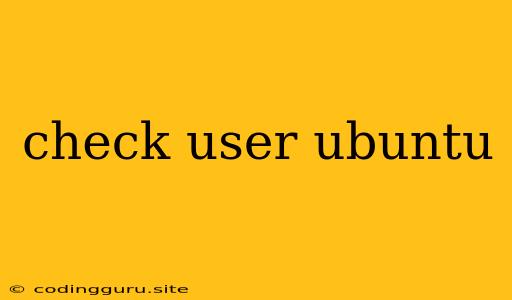Checking Users in Ubuntu: A Comprehensive Guide
When working with Ubuntu, managing users is a fundamental task. Understanding how to check existing users, their details, and permissions is essential for maintaining system security and ensuring smooth operation. This guide provides a comprehensive overview of various methods for checking users in Ubuntu.
Why is Checking Users Important?
Knowing who has access to your Ubuntu system is crucial for several reasons:
- Security: Identifying users helps you understand potential security risks and prevent unauthorized access.
- Resource Management: Checking users allows you to monitor resource usage and identify any potential issues related to user accounts.
- Troubleshooting: When encountering system errors, knowing which user is involved can be critical for troubleshooting and resolving the problem.
Common Commands for Checking Users
Here are some essential commands you can use to check users in Ubuntu:
1. whoami: This simple command tells you the name of the user currently logged in.
$ whoami
user1
2. id: This command provides detailed information about the current user, including their user ID (UID), group ID (GID), and groups they belong to.
$ id
uid=1000(user1) gid=1000(user1) groups=1000(user1),4(adm),24(cdrom),27(sudo),30(dip),46(plugdev),113(lpadmin),124(sambashare),999(users)
3. users: This command displays a list of all currently logged-in users on the system.
$ users
user1
4. who: Provides more information about logged-in users, including their terminal, login time, and idle time.
$ who
user1 pts/0 2023-10-26 10:00 (10.1.1.10)
5. w: This command gives a more detailed output, including the processes running for each user.
$ w
USER TTY FROM LOGIN@ IDLE JCPU PCPU WHAT
user1 pts/0 10.1.1.10 10:00 0.00s 0.01s 0.00s -bash
6. finger: This command allows you to retrieve information about a specific user, including their login shell, home directory, and recent login activity.
$ finger user1
Login: user1 Name: User One
Directory: /home/user1 Shell: /bin/bash
Last login: Thu Oct 26 10:00:00 2023 from 10.1.1.10
7. getent passwd: This command lists all users defined in the /etc/passwd file, providing information such as their username, UID, GID, home directory, and login shell.
$ getent passwd
user1:x:1000:1000:User One:/home/user1:/bin/bash
8. getent group: This command lists all groups defined in the /etc/group file, providing information such as their group name, GID, and member users.
$ getent group
user1:x:1000:user1
adm:x:4:syslog,user1
How to Find Information About a Specific User
To check the details of a particular user, you can use the following commands:
id username: This command provides information about a specific user, similar to theidcommand for the current user.
$ id user2
uid=1001(user2) gid=1001(user2) groups=1001(user2),24(cdrom),27(sudo),46(plugdev),113(lpadmin),124(sambashare),999(users)
finger username: This command retrieves information about a specific user, as mentioned earlier.
$ finger user2
Login: user2 Name: User Two
Directory: /home/user2 Shell: /bin/bash
Last login: Thu Oct 26 10:15:00 2023 from 10.1.1.15
Checking User Permissions
To understand what a user can do on the system, you need to check their permissions. Here's how:
ls -l: This command lists files and directories with detailed permissions.
$ ls -l /home/user1
drwxr-xr-x 2 user1 user1 4096 Oct 26 10:00 documents
groups username: This command lists the groups a user belongs to.
$ groups user2
user2 adm cdrom sudo plugdev lpadmin sambashare users
Understanding File Permissions:
File permissions in Ubuntu use the following format:
rwxr-xr-x
- r: Read permission
- w: Write permission
- x: Execute permission
The first set of permissions (rwx) applies to the file owner, the second set (r-x) to the group, and the last set (r-x) to everyone else.
Checking User Activity
To monitor a user's recent activity, you can use the following commands:
last username: This command displays the last login attempts for a user.
$ last user1
user1 pts/0 10.1.1.10 Thu Oct 26 10:00 - still logged in
history: This command shows the history of commands executed by the current user.
$ history
1 whoami
2 id
3 users
4 who
5 w
6 finger user1
7 getent passwd
Tips for Working with Users in Ubuntu
- Best Practices: Regularly review user permissions and ensure they have only the necessary access.
- Security Measures: Use strong passwords and enable two-factor authentication to enhance security.
- Documentation: Keep a record of all users, their permissions, and any changes made to user accounts.
- System Monitoring: Regularly check user activity and resource usage to identify any suspicious behavior.
Conclusion
Checking users is a fundamental task for system administrators and users alike. By understanding the commands and methods outlined in this guide, you can effectively manage and secure your Ubuntu system. Remember to prioritize security, follow best practices, and regularly monitor user activity to maintain a stable and protected environment.
